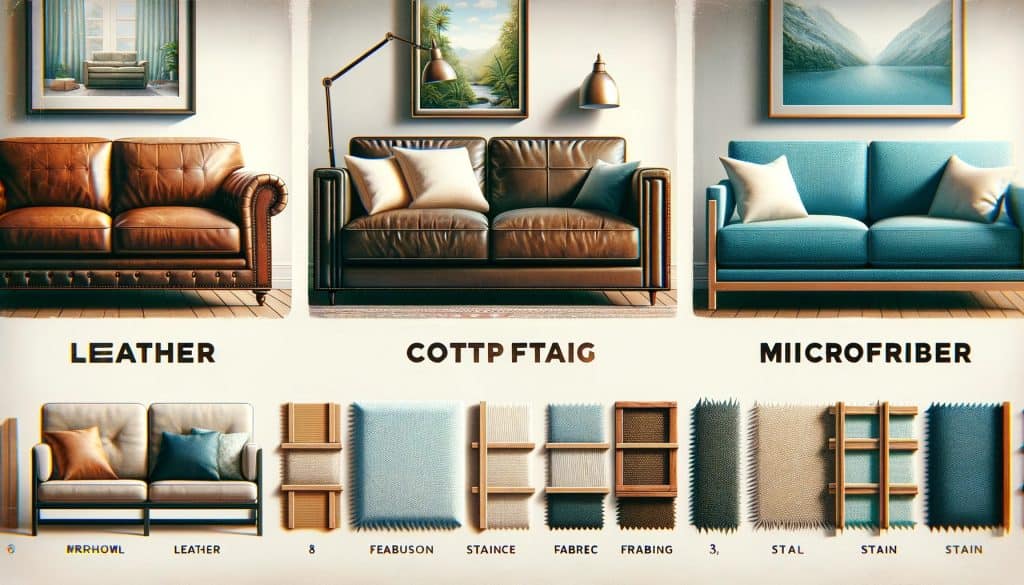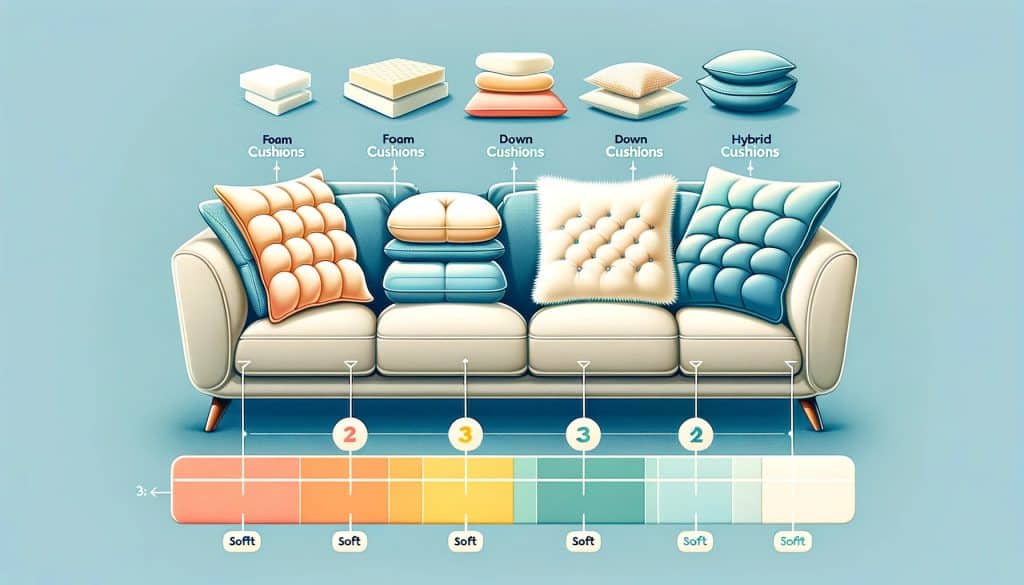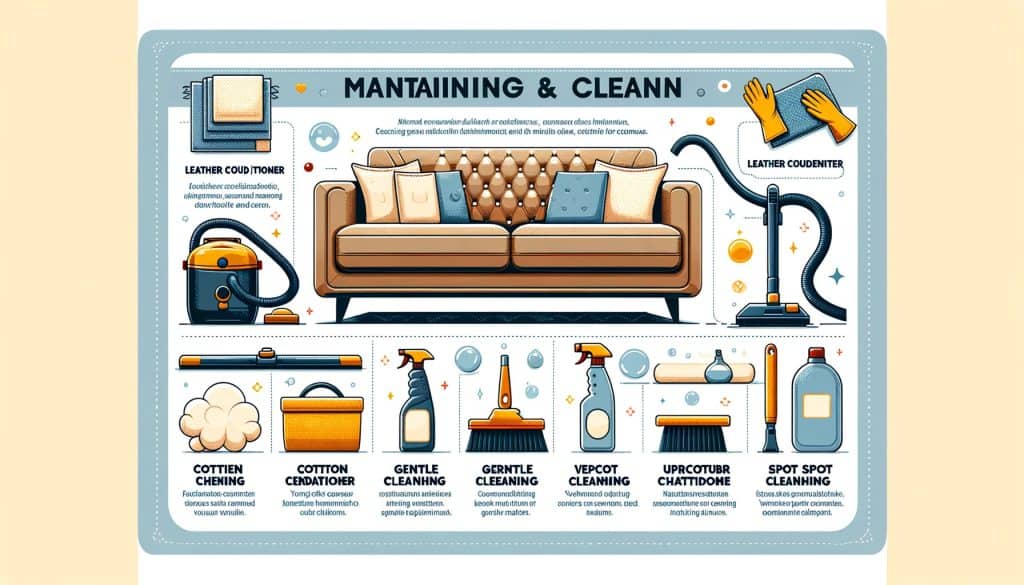Imagine walking into a living room where the couch isn’t just a piece of furniture, but the heart of the room. This is where stories are shared, movies are watched, and countless moments of relaxation occur. A comfortable and stylish couch is not just a seating option; it’s the centerpiece that brings life, warmth, and personality to your living space.
I remember the time I went hunting for the perfect couch. My old one, a hand-me-down from my parents, had seen better days.
The search wasn’t just about finding a new couch; it was about discovering a piece that would redefine my living space, a place where I spend most of my downtime. I wanted something that wasn’t just comfortable to sit on but also reflected my personal style.
Visiting different stores, I was amazed by the variety – from plush, oversized sectionals to sleek, modern designs. Each had its own character, promising comfort and a unique aesthetic. I recall sitting on each, imagining how it would fit into my living room, how it would feel hosting friends for a movie night, or curling up with a book on a lazy Sunday.
The journey taught me that choosing the right couch is more than a practical decision; it’s about creating an environment that resonates with who you are. The couch you choose sets the tone for the rest of the room, influencing everything from the mood to the functionality of the space.
In this article, we’ll explore how to find that perfect couch, one that blends comfort with style, and transforms your living room into a haven of relaxation and style.
Whether you’re looking for something classic and timeless or bold and modern, the right couch is out there waiting for you. Let’s embark on this journey together, and turn your living room into the heart of your home.
< class="wp-block-separator has-alpha-channel-opacity"/>Understanding Different Couch Styles
When it comes to couch styles, there’s a world of options out there, each with its unique charm and functionality. Let’s break down the t ee popular styles: classic, modern, and sectionals, to help you decide which might be the right fit for your living space.

1. Classic Sofas: The Timeless Chesterfield
- Characteristics: The Chesterfield sofa is a symbol of timeless elegance. Known for its deep button tufting, rich leather upholstery, and rolled arms, it exudes a classic charm that’s hard to overlook. Often found in dark hues, it makes a statement of sophistication and style.
- Good Fit: Perfect for formal living rooms or spaces where you want to create a traditional, upscale ambiance. Its robust structure and refined aesthetic make it ideal for elegant settings, libraries, or spaces where a touch of class is desired.
- Comfort Level: It’s not just about looks; Chesterfields are surprisingly comfortable, offering firm support and a sense of grandeur.
2. Modern Sofas: Sleek and Minimalist
- Characteristics: Modern sofas are all about clean lines, simplicity, and functionality. They often feature a minimalist design with less ornamentation, focusing on sleek shapes and neutral color palettes. Materials vary from leather to soft fabrics, catering to a contemporary aesthetic.
- Good Fit: Ideal for modern living spaces, apartments, and lofts where space might be limited, and a clean, uncluttered look is desired. Their versatile design pairs well with a variety of decor styles, from ultra-modern to transitional.
- Comfort Level: Modern sofas prioritize both style and comfort, often featuring plush cushions and ergonomic designs for a cozy seating experience.
3. Sectional Sofas: Versatile and Spacious
- Characteristics: Sectionals are the ultimate in comfort and versatility. These sofas come in various configurations, like L-shaped or U-shaped, allowing for customizable arrangements. They offer ample seating, making them perfect for larger families or entertaining guests.
- Good Fit: Great for spacious living rooms, family rooms, or media rooms where seating capacity and comfort are priorities. They are ideal for creating a cozy, communal area in open-plan spaces.
- Comfort Level: With plush cushions and generous seating areas, sectionals are the go-to for a relaxed, laid-back seating experience. They’re perfect for lounging, napping, or gathering with friends and family.
Understanding these styles helps narrow down your choices based on your space, aesthetic preferences, and comfort needs. Whether you lean towards the classic elegance of a Chesterfield, the sleek appeal of a modern sofa, or the spacious comfort of a sectional, there’s a perfect couch waiting to transform your living space.
< class="wp-block-separator has-alpha-channel-opacity"/>Materials Matter: Choosing the Right Fabric and Frame
Selecting the right materials for your couch is crucial not just for its look but also for its durability and comfort. Here, we’ll explore popular fabric choices and frame materials to help you make an informed decision.

Fabric Choices
- Leather
- Pros:
- Durability: Leather is known for its longevity and ability to withstand wear and tear.
- Easy to Clean: Spills and stains can be easily wiped off.
- Aesthetic Appeal: Adds a touch of elegance and sophistication.
- Cons:
- Price: Generally more expensive than other materials.
- Sensitivity to Conditions: Can crack or fade with exposure to sunlight or extreme temperatures.
- Pros:
- Cotton
- Pros:
- Comfort: Soft and pleasant to touch, offering great comfort.
- Breathable: Keeps cool in summer and warm in winter.
- Variety: Available in a wide range of colors and patterns.
- Cons:
- Maintenance: More prone to stains and requires regular cleaning.
- Durability: Less durable than leather, especially in high-traffic areas.
- Pros:
- Microfiber
- Pros:
- Stain Resistance: Highly resistant to stains and spills.
- Soft Texture: Offers a comfy and cozy feel.
- Allergy-Friendly: Doesn’t attract dust or allergens easily.
- Cons:
- Static: Can generate static electricity.
- Sensitive to Water: Water spots can be difficult to remove.
- Pros:
Frame Materials
- Wood
- Advantages:
- Strength: Offers robust support and long-lasting durability.
- Aesthetic Variety: Comes in various finishes and styles to match different decor themes.
- Natural Look: Adds a warm and organic feel to the room.
- Considerations:
- Weight: Can be heavy, making the couch difficult to move.
- Maintenance: Requires occasional treatment to maintain its look and strength.
- Advantages:
- Metal
- Advantages:
- Modern Appeal: Gives a contemporary and sleek look to the couch.
- Durability: Resistant to warping and bending, ensuring a long lifespan.
- Support: Provides sturdy support, especially for sleeper sofas and futons.
- Considerations:
- Comfort: Can feel less warm and inviting compared to wood.
- Corrosion: May require maintenance to prevent rust and corrosion.
- Advantages:
Choosing the right combination of fabric and frame material is about balancing aesthetics, comfort, and durability. Whether you prefer the classic elegance of leather, the cozy comfort of cotton, or the practicality of microfiber, coupled with the sturdy support of wood or metal frames, there’s a combination that perfectly suits your needs and style.
< class="wp-block-separator has-alpha-channel-opacity"/>Size and Shape: Fitting Your Space and Style
Choosing the right size and shape for your couch is key to creating a harmonious and functional living space. Here are some practical tips for measuring your space and considering different couch shapes.

Measuring Your Space
- Determine the Layout:
- Before you start measuring, decide where you want the couch to go. Consider foot traffic, the position of other furniture, and the room’s focal points (like a fireplace or TV).
- Measure the Available Space:
- Use a tape measure to get the length and width of the space where you’ll place the couch. Don’t forget to measure the height if you’re considering a couch with a high back.
- Remember to leave enough space around the couch for walking and other furniture.
- Consider Doorways and Hallways:
- Ensure the couch can fit t ough doorways, hallways, and any tight turns into your living space.
- Mock-up the Space:
- If you’re unsure about the size, use painter’s tape or newspapers to mark the couch’s footprint on the floor. This visual guide can help you imagine how the couch will fit into your room.
Shape Considerations
- L-Shaped Couches:
- Ideal for open-plan spaces or larger living rooms.
- Great for dividing the room into separate areas, like a lounge area and a dining space.
- Offers ample seating and can be used to maximize corner spaces.
- U-Shaped Couches:
- Perfect for spacious rooms or for creating a cozy, enclosed seating area.
- Provides a lot of seating, making it suitable for large families or those who entertain often.
- Works well for creating a conversational setting.
- Straight Sofas:
- A classic choice that fits well in most room layouts.
- Versatile and can be paired with chairs or a loveseat for additional seating.
- Modular Sofas:
- Composed of multiple pieces that can be arranged in various configurations.
- Ideal for those who like flexibility in their furniture layout.
By carefully measuring your space and considering the shape of the couch, you can ensure that your new couch not only fits perfectly in your living room but also enhances its overall look and functionality.
Whether you go for an L-shaped sectional to maximize corner space or a classic straight sofa for a more flexible layout, the right size and shape can make all the difference in creating a comfortable and stylish living area.
< class="wp-block-separator has-alpha-channel-opacity"/>Comfort is Key: Cushions and Comfort Levels
When it comes to couches, comfort is as important as style. The right cushion can transform your seating experience. Let’s explore the different types of cushions and how to find the right level of firmness.

Cushion Types
- Foam Cushions:
- Features: Foam cushions are known for their firmness and support. They hold their shape well and offer a more structured look.
- Good For: Those who prefer a firmer seat and need more support, especially in the back and hips.
- Maintenance: Foam cushions require less fluffing and maintenance compared to softer materials.
- Down Cushions:
- Features: Down cushions are filled with feathers, making them exceptionally soft and plush.
- Good For: Those who love a cushy, luxurious feel. They are perfect for lounging and sinking into comfort.
- Maintenance: Require regular fluffing to maintain their shape and comfort.
- Hybrid Cushions:
- Features: Hybrid cushions combine foam and down, offering the best of both worlds – the support of foam with the softness of down.
- Good For: Those who want comfort without compromising on support.
- Maintenance: Easier to maintain than pure down cushions but may still require occasional fluffing.
Finding the Right Firmness
- Understand Your Comfort Needs:
- Think about how you prefer to use your couch. Do you like to sit upright and need support, or do you prefer to sink into your sofa?
- Test Different Firmness Levels:
- If possible, visit a store to test different firmness levels. Sit on various couches to see what feels most comfortable to you.
- Consider Long-Term Use:
- Firmer cushions tend to retain their shape and offer support longer than softer ones, which may flatten over time.
- Health Considerations:
- If you have back issues or other health concerns, opt for a firmer cushion that provides adequate support.
- Lifestyle Factors:
- If you have kids or pets, firmer cushions might be more practical as they are easier to clean and maintain.
Comfort is subjective, and what feels perfect for one person might not for another. By understanding the different types of cushions and considering your own comfort needs and lifestyle, you can select a couch that’s not only a joy to sit on but also supports your body in all the right places.
< class="wp-block-separator has-alpha-channel-opacity"/>Color and Patterns: Matching Your Decor
The color and pattern of your couch can dramatically affect the overall look and feel of your living room. Let’s dive into the world of colors and patterns to help you choose the best option for your space.

Neutral vs. Bold Colors
- Neutral Colors (Beige, Gray, White)
- Advantages:
- Versatility: Neutral colors blend well with any decor style and color scheme.
- Timelessness: They rarely go out of style and can adapt to changing trends.
- Flexibility: Easy to accessorize with different colored pillows and t ows.
- Choosing Neutrals:
- Consider a neutral couch if your walls or decor are already bold or if you enjoy changing your accessories frequently.
- Advantages:
- Bold Colors (Red, Blue, Green)
- Advantages:
- Statement Piece: A bold-colored couch can be the focal point of the room.
- Personality: Adds character and vibrancy to your space.
- Mood Setting: Colors can influence the mood and ambiance of the room.
- Choosing Bold Colors:
- Opt for a bold color if you want to inject energy and excitement into your space. Ensure it complements your existing decor and doesn’t overwhelm the room.
- Advantages:
Patterned vs. Solid
- Patterned Couches (Floral, Geometric)
- When to Choose Patterns:
- If you have solid-colored walls and flooring, a patterned couch can add interest and depth.
- Great for hiding stains and wear, making them practical for high-traffic areas.
- Choose a pattern that reflects your personality and ties together other colors in your room.
- When to Choose Patterns:
- Solid-Colored Couches
- When to Keep it Simple:
- If your room already has a lot of patterns (like patterned rugs or wallpaper), a solid-colored couch can provide balance.
- Easier to accessorize with patterned cushions or t ows.
- Offers a clean, uncluttered look that can make smaller spaces feel larger.
- When to Keep it Simple:
Choosing the right color and pattern for your couch is about finding the balance that works for your space and style.
Whether you go for a classic neutral that offers flexibility or a bold color that makes a statement, or decide between a lively pattern and a simple solid, your couch can set the tone for your living room’s decor. The key is to pick something that not only looks great but also feels like a true reflection of your style and personality.
< class="wp-block-separator has-alpha-channel-opacity"/>Additional Features to Consider
When selecting a couch, besides style, material, and size, there are additional features that can significantly enhance functionality and comfort. Let’s explore some of these features.

Storage Options
- Couches with Built-in Storage:
- Benefits:
- Space-Saving: Ideal for small apartments or rooms where extra storage is needed.
- Clutter-Free: Keeps living spaces tidy by providing a place to store items like blankets, books, or remote controls.
- Designs:
- Many storage couches come with compartments under the seats or in the armrests.
- Some have drawers or ottomans with storage space.
- Perfect For:
- Those who value a clean, organized living space and need extra storage without compromising on style.
- Benefits:
Reclining Features
- Reclining Couches:
- Benefits:
- Enhanced Comfort: Allows you to adjust your seating position for optimal comfort.
- Versatile: Suitable for watching TV, reading, or napping.
- Types:
- Manual recliners use a lever or pull tab, while power recliners offer a button or remote control for smooth adjustment.
- Perfect For:
- Anyone looking for added comfort, especially beneficial for people with mobility issues or those who spend a lot of time in their living room.
- Benefits:
Convertible Couches
- Sleeper Sofas:
- Utility:
- Multi-Functional: Serve as a couch during the day and transform into a bed for guests at night.
- Space-Efficient: A great solution for small spaces or homes without a dedicated guest room.
- Varieties:
- Range from pull-out bed designs to futons and daybeds, accommodating different space and comfort needs.
- Perfect For:
- Those who frequently have guests stay over but lack the space for a guest room. Also ideal for studio apartments or multipurpose rooms.
- Utility:
These additional features can make a world of difference in your living room, offering not just a place to sit, but also extra storage, comfort, and versatility. Whether it’s the practicality of built-in storage, the relaxation of a reclining feature, or the adaptability of a convertible couch, these options add value and functionality to your living space.
< class="wp-block-separator has-alpha-channel-opacity"/>Maintenance and Care
Keeping your couch in top shape not only extends its life but also keeps it looking great. Different materials require different care strategies. Here are some tips for maintaining and cleaning various types of couch fabrics.

Leather Couches
- Regular Dusting and Vacuuming:
- Use a soft brush attachment to gently vacuum the surface and crevices.
- Wipe with a soft, dry cloth to remove dust.
- Spot Cleaning:
- For spills, use a damp cloth to blot the spill immediately. Avoid rubbing, as it can spread the stain.
- Use a specialized leather cleaner for stubborn stains, following the product’s instructions.
- Conditioning:
- Apply a leather conditioner every 6-12 months to keep the leather supple and prevent cracking.
- Avoid Direct Sunlight and Heat:
- Prolonged exposure can cause leather to fade and crack.
Cotton and Microfiber Couches
- Regular Vacuuming:
- Use an upholstery attachment to remove dust and loose dirt.
- Spot Cleaning:
- Blot spills immediately with a clean, dry cloth.
- Use a mild detergent solution for stains. Test it on a small, inconspicuous area first.
- Machine-Washable Covers:
- If your couch has removable covers, follow the washing instructions carefully.
- Professional Cleaning:
- For deep cleaning or tough stains, consider hiring a professional upholstery cleaning service.
General Tips
- Immediate Attention to Spills:
- Acting fast can prevent stains from setting in.
- Use Appropriate Cleaning Agents:
- Always check the manufacturer’s recommendations before using any cleaning products.
- Regular Maintenance:
- Regular cleaning extends the life of your couch and keeps it looking fresh.
- Avoid Harsh Chemicals:
- Harsh cleaners can damage the fabric. Always opt for gentler options.
By following these care and maintenance tips, you can ensure your couch remains a cozy and attractive centerpiece in your living room for years to come. Regular upkeep not only enhances the appearance but also contributes to the overall ambiance and comfort of your space.
< class="wp-block-separator has-alpha-channel-opacity"/>Budgeting for Your Couch
Setting a budget for your new couch is a crucial step in the buying process. It ensures you get the best value for your money without overspending. Here’s how to approach budgeting for your couch:

- Assess Your Needs:
- Consider what you need in a couch – size, material, style, and additional features. Prioritize these factors as they will influence the cost.
- Research Average Prices:
- Look up the average prices for the type of couch you want. Prices can vary widely based on materials, brands, and features.
- Set a Realistic Budget:
- Based on your research, set a budget that reflects the average cost but also takes into account your financial constraints.
- Remember to include extra costs like delivery fees or extended warranties.
- Balance Cost with Quality:
- While it’s tempting to go for cheaper options, investing in a higher-quality couch may be more cost-effective in the long run.
- Consider durability, maintenance costs, and warranties.
- Look for Deals and Discounts:
- Keep an eye out for sales, especially during holidays or off-season periods.
- Check out clearance sections or floor models for discounts.
- Consider Financing Options:
- If you find the perfect couch that’s slightly above your budget, consider financing options, but be cautious of interest rates and repayment terms.
- Don’t Compromise on Key Features:
- Stick to your must-haves. It’s better to wait and save up a bit more rather than settling for a couch that doesn’t meet your needs.
- Used or Refurbished Options:
- Consider buying a used or refurbished couch as a budget-friendly option. Ensure it’s in good condition and check for cleanliness.
Budgeting for a couch is about finding the sweet spot where cost, quality, and your personal needs meet. By carefully planning your budget and understanding the factors that influence couch prices, you can make a smart purchase that brings comfort and style to your home without breaking the bank.
< class="wp-block-separator has-alpha-channel-opacity"/>Conclusion
Choosing the perfect couch for your living room is a journey that blends style, comfort, and functionality. It’s about finding a piece that not only complements your space but also reflects your personal style and meets your comfort needs.

- Style Variety: Whether you lean towards the timeless elegance of classic sofas, the clean lines of modern designs, or the spacious comfort of sectionals, there’s a style for every taste.
- Material Choices: From the sophistication of leather to the cozy feel of cotton and the practicality of microfiber, each material offers its unique benefits.
- Color and Pattern: Whether you opt for neutral tones for timeless elegance or bold colors and patterns to make a statement, your choice can set the tone for the entire room.
- Comfort and Support: The right cushioning, whether it’s firm foam, plush down, or a hybrid, ensures your couch isn’t just good-looking but also comfortable.
- Additional Features: Features like built-in storage, reclining options, or convertible designs add functionality and versatility to your living space.
- Maintenance: Keeping in mind the care and maintenance for different materials will ensure your couch stays looking great for years to come.
- Budgeting: Setting a realistic budget and understanding the factors that influence the cost will help you find the best value for your money.
Remember, your couch is more than just a place to sit; it’s a central part of your daily life and a reflection of your lifestyle. So, take your time, consider all the factors, and choose a couch that you’ll be happy to come home to, day after day. Let your couch be a source of comfort, style, and joy in your living room.


